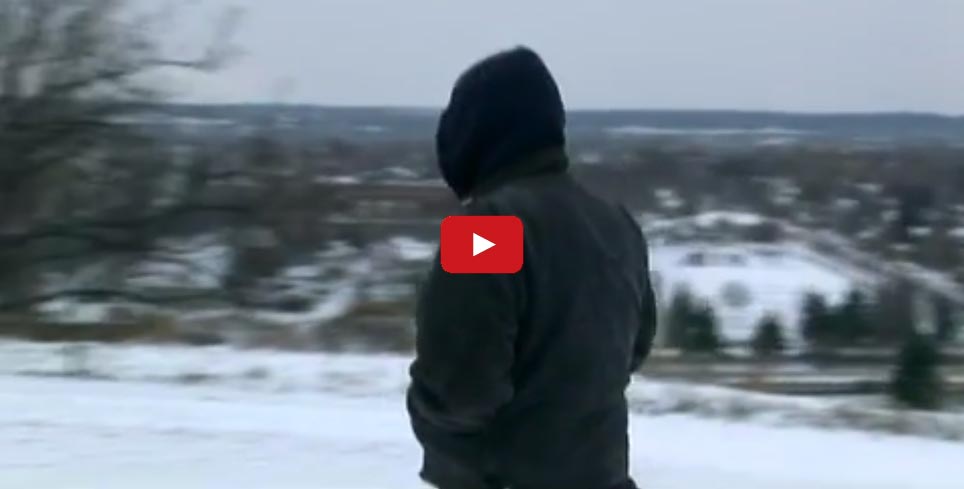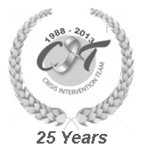August 2022 MOU between UCMT and MPD
UCMT/MPD MOU
Updated 8/3/2022
This Memorandum of Understanding, (“MOU”), is a living document. It began life as the 2003 MOA between the Minneapolis Police Department, MPD, under Chief Robert Olson, and the Unity Community Mediation Team, UCMT, led by Ron Edwards and Clyde Bellecourt. It was signed at the Urban League Building on Plymouth and Penn Avenues in North Minneapolis on December 4, 2003, after two years of meetings and negotiations between the MPD and the UCMT in a mediation process led by the Community Relations Service of the United States Department of Justice (“CRS”). The mediation was agreed to by both sides in the face of a history of police violence against the communities represented in the UCMT, African American, American Indian, Latino, LGBTQ and the behavioral health community representatives. The MOA created the Police Community Relations Council, PCRC, a self-governing entity made up of the two sides in the mediation effort, the UCMT and the MPD.
After the signing of the MOA, the two sides met, often weekly, for five years on the implementation of the 106 action items agreed to in the MOA. By 2008, the then mayor of Minneapolis decided not to continue to participate in the PCRC process created by the MOA 70% of the action items were complete. Once the two parties stopped meeting as the PCRC, the transformation momentum receded since the pressure for change from the PCRC had been removed from the picture.
On May 25, 2020 George Floyd died at the hands of Minneapolis police officers in an event that shook Minneapolis and reverberated around the world. The next day, one of the UCMT signers of the MOA reached out to CRS to request their assistance in reconvening the PCRC. The DOJ agreed as did the then Chief of the department, Medaria Arradondo, who had also been an original signer of the MOA when he was a Sergeant. Following his retirement in early 2022, Interim MPD Chief Amelia Huffman continued to move forward with this process and with MPD’s partnership with UCMT to update and add new needed language to the MOA, agreeing to make the PCRC a permanent part of the community engagement work of MPD.
The UCMT worked for over two years to draft updates and additions to the original MOA with MPD leadership, the Police Officers Federation, our communities and the Young People’s Taskforce and on June 23, 2022 transmitted the language agreed to by UCMT and MPD to MPD Chief Amelia Huffman, Minneapolis Mayor Jacob Frey, Sergeant Sherral Schmidt the President of the Police Officers Federation of Minneapolis, and the broader community. The UCMT and MPD have agreed to reconvene the PCRC as a permanent process to lead the transformation of MPD and the community with transparency, accountability and consequences. As conditions, laws, understanding and relationships continue to evolve in Minneapolis, PCRC (UCMT and MPD) will continue to meet and confer as per section 2 of the MOU to continually improve the public safety systems and the communities in Minneapolis.
UCMT and the MPD recognize that this MOU comes at a critical moment: (1) the Minnesota Department of Human Rights and the United States Department of Justice have both commenced investigation of whether the City or MPD has engaged in a pattern or practice of unlawful policing pursuant to the jurisdiction of each entity; (2) City and MPD are subject to the jurisdiction of both the MDHR and the DOJ; (3) MDHR’s and DOJ’s investigation and jurisdiction overlap significantly with the subject matter of this MOU; and (3) the MDHR completed its investigation in April 2022 and the City and MDHR are currently negotiating to resolve the MDHR’s claims that there is probable cause to believe that MPD has engaged in a pattern or practice of discriminatory policing; (4) the DOJ’s investigation is ongoing and the City anticipates entering into a consent decree with the DOJ regarding the subject of its investigation; (5) it will not serve the UCMT and MPD’s shared goals of non-discriminatory policing, for the City to be subject to inconsistent agreements on overlapping issues; (6) the MPD and UCMT do not wish to wait indefinitely for the City and MDHR to conclude its negotiations, or for the DOJ to conclude its investigation, before making meaningful and lasting change. For these reasons, this MOU is an important form of engagement with crucial community stakeholders and represents the UCMT and MPD’s shared and current understanding of what policing should look like in Minneapolis. However, UCMT and MPD acknowledge that there are ongoing legal processes occurring with MDHR and DOJ and that the resolution of those processes will likely impact the matters addressed in this MOU. As noted above, as conditions, laws, understanding and relationships continue to evolve in Minneapolis, PCRC and MPD will continue to meet and confer regarding this MOU to continually improve the public safety systems and the relationships between UCMT and MPD. In addition, there may be a change in circumstances impacting the matters addressed in this MOU.
This document is a statement reflecting shared principles of UCMT and MPD, and a recognition of the important relationship between the communities represented by UCMT and MPD and its contribution to public safety and trust between MPD and the communities it serves.
Section 1. Use of Force. The sanctity of life shall be our first priority. The MPD recognizes that the use of force by it officers is a concern to the people of Minneapolis. Many people of color: African Americans, Native Americans, Latino, African immigrants, women, members of the LGBTQ community, the disability and mental health communities feel particularly vulnerable to the use of force, and use of excessive force and related issues such as vulgar/profane language, threatening language, coded language and threatening body posture/movements by police officers. Members of Minneapolis’s communities have expressed that they feel and experience the total disregard and disrespect of our humanity and basic rights as human beings in Minneapolis. MPD employees shall actively listen, empathize, build rapport, and be creative in communicating and partnering with community members, City and County service providers, health and behavioral health professionals. The goal of de-escalation is to maintain safety for all while gaining trust of officers and achieving voluntary compliance. The MPD acknowledges the vital role of education and training in recognizing the effect of implicit bias in policing and public safety. Accordingly, the parties agree to the following provisions regarding the use of force by MPD officers.
- Authorized Use of Force. The standard establishing when the use of force is authorized is governed by Minnesota statutes and state and federal case law: Minnesota statue 609.06, authorized use of force; 609.066 authorized use of deadly force by Licensed Peace Officers. MPD agrees that fear, hate, and or personal biases based on “race,” culture, or ethnicity of an individual is never a basis to authorize the use of force.
- POST Board Model Policies. MPD agrees to maintain use of force policies that are identical or substantially similar to the MN POST Board model policies. MPD officers shall only use the amount of force that is objectively reasonable. MPD officers should use the lowest level of force necessary for safety and control.
1.2 Policies Related to the Use of Force.
1.2.1 Use of Force Policies. UCMT has reviewed the Minnesota POST Board policy and approves of and recommends acceptance of the policy. The use of deadly force is based on MN Statute 609.066 and applicable federal law including Code of Federation Regulation Title 10, Chapter 10, Part 1047.7. (MPD P/P 5-301 I. B.)
1.2.2 Reporting Use of Force. MPD agrees that it will maintain its
policy that an officer file a report in each instance of a use of
force. Reportable use of force is defined as, “An intentional,
direct or indirect, bodily contact that causes pain or injury or
restricts someone’s movement. Intentionally placing someone
in fear of such contact, or threatening such contact, also
constitutes force.” This includes, but is not limited to:
- The use of any weapons, substance, vehicle, equipment, tool, device or animal that inflicts pain or produces injury to another;
- Any physical strike to any part of the body of another;
- Any physical contact or threat of contact by the officer or a weapon that causes or threatens to cause pain or injury to another;
- Any physical contact or threat of physical contact by the officer that results in restraint or physical manipulation of the physical movement of another;
- Unholstering or displaying a weapon, when engaged with a subject or subjects.
In addition to requiring an officer using force to submit a
written report, the officer will also report the incident to an on-
duty supervisor. (MPD P/P 5-301, III. H. Report Required)
(MPD P/P 5-301, IV., B. Use of Force and De-Escalation
Reporting) (MPD P/P 5-301, IV., D. Supervisor Force Review)
1.2.3 Supervisor Force Reviews. When a supervisor is notified of a Use of
Force, In-Custody Injury or Illness incident, the supervisor shall:
- Respond to the Incident Scene to conduct a preliminary investigation of the Use of Force or Injury/Illness incident,
- Debrief the Employee who engaged in the use of force,
- Note any responded injury or alleged injury to the individual involved,
- Photograph the force subject and any injuries
- Note whether any medical aid was provided to the individual involved,
- Locate and review any evidence related to the force or injury incident and ensure that any on-scene evidence is preserved and collected,
- Take best efforts to locate and identify witnesses to the use of force or injury incident and obtain statements from those witnesses,
- Contact the Internal Affairs Unit Commander immediately if the force used appears to be unreasonable or appears to constitute possible misconduct,
- Complete and submit both the Supervisor Use of Force Review template and narrative text as soon as practical, but prior to the end of that shift,
- Review all sworn employees’ reports and narrative texts related to the use of force or injury incident for completeness and
accuracy.
The MPD will maintain a record of use of force reports and highlight cases where data may be incomplete. These cases shall be reviewed weekly by the appropriate member of MPD command staff, and supervisors will be required to follow-up with the employee reporting the force to ensure the report is updated for accuracy and completeness. MPD will maintain a public facing Use of Force dashboard to report on use of force. (MPD P/P 5-301, IV., D. Supervisor Force Review)
- Use of Force and Body-worn Cameras, BWC. MPD agrees that when a use of force incident is captured on a body-worn camera, sworn employees shall ensure that the BWC is uploaded and that the event is properly classified. Proper classification of a use of force incident would include, “Use of Force – Other,” or “Use of Force – Significant Bodily Injury.”
The supervisor conducting the supervisor’s force review shall review any BWC video that is related to a use of force incident or complaint of misconduct and ensure that the video has been marked with the appropriate classification.
The MPD agrees to continue use of the Quality Assurance Unit BWC audits, and MPD Command Staff will ensure that supervisors continue to review videos flagged for audit.
MPD agrees to follow the Complaint Process Manual and conduct Training, Coaching or impose discipline for officers and supervisors failing to comply with MPD Policy and Procedure 4-223 regarding Body Worn Cameras. (MPD P/P 4-223 Body Worn Cameras)
1.2.5 Hand cuffing. Every person being placed in hand cuffs shall have those hand cuffs double locked immediately upon application, or once safe to do so. These applied hand cuffs shall be in proper position and double locked to prevent the hand cuffs from becoming over tight as person hand cuffed may move. Hand cuffs placed improperly or single locked can cause harm including great bodily harm to the person cuffed. MPD officers or employees violating this policy are subject to disciplinary action. MPD policy 5-302.
1.2.6 Duty to Render Care. MPD officers and anyone acting under their direction, shall use only the necessary force to secure person/or scene safely. Use of force on a person/s shall be continually evaluated and reduced/elevated as needed in a timely manner. Use of force causing injury to a person, shall be relieved to a safe point, and medical attention rendered immediately by MPD or other emergency services personnel identified or self-identifying as qualified medical provider, in uniform or plain clothes, with consideration given to safety and security of everyone. (MPD P/P 5-301 III. A. 3. a. ii. Sworn MPD employees shall only use the amount of force that is objectively reasonable)
1.2.7 Warrior Style Training Prohibited. MPD officers will not participate in training that de-humanizes individuals or encourages aggressive conduct that de-emphasizes the value of human life or constitutional rights or increases the likelihood of use of deadly force unnecessarily, violates the sanctity of life principle. Minnesota statute 626.8434
1.2.8 Every MPD officer that has received Warrior Training shall be trained to serve and protect with compassion.
1.2.9 Steroid Use. MPD officers using any type of performance enhancing steroid, without a legal prescription, shall report such use to the Health and Wellness Coordinator. The officer shall be evaluated for fitness for duty under section 3 of this agreement. (MPD P/P 3-501 IV. G. Prescription and Over the Counter Medications)
1.3 Enforcement of Use of Force Policy.
1.3.1 Consequences for Violation. An officer, supervisor, or field training officer who fails to comply with a policy contained in the MPD manual,
including specifically the aforementioned policies regarding use of force, is subject to disciplinary action, and reassignment to nonenforcement duty as appropriate.
1.4 Less Lethal Tools. The MPD will request from City Council a budget necessary to
ensure that all precincts are supplied with a
sufficient number of less lethal weapons and personnel properly trained in the use
of such weapons. Only MPD personnel properly trained and certified on proper
use of these weapons shall use them. It is anticipated that the MPD will continue to provide each precinct with at least three 40mm multi-launchers. MPD anticipates continuing to provide patrol officers with a Conducted Energy Device. The MPD will continue to research and evaluate the state of the art in less-lethal weapons use by law enforcement personnel. When appropriate the MPD will update and or upgrade its arsenal of less lethal weapons. (MPD P/P 5-302 III. F. Less-Lethal 40mm Launcher and Impact Projectiles)
1.4.1 Crowd Control Weapons. The MPD shall use designated crowd control weapons consistent with the requirements of the MN Department of Human Rights as described in the Temporary Restraining Order (Lucero v City of Minneapolis). Specifically, during protests and demonstrations, use of all crowd control weapons on a crowd must be authorized by the Chief, or in the absence of the Chief, the Chief’s designee at the rank of Deputy Chief or higher.
If there is an immediate need to protect oneself or another from objectively imminent physical harm and the use of crowd control weapons on the crowd have not been authorized, crowd control weapons, excluding chemical munitions, smoke munitions and light sound distraction devices, may be used without prior authorization in order to stop the assaultive conduct or act of violence. In these circumstances, crowd control weapons may only be used against specific
persons who are posing a threat of objectively imminent physical harm to another person.
MPD shall not use tear gas, rubber bullets, bean bags or other projectiles as a method of peaceful crowd control. MPD agrees to abide by this policy even when working under a joint powers agreement with another jurisdiction.
1.4.2 Unauthorized Use of Crowd Control Weapons. MPD officers using
crowd control weapons in a manner not consistent with policy, training
or law will be subject to discipline up to and including termination.
1.4.3 De-escalation. (Taking action or communicating
verbally or non-verbally during a potential force encounter, in an attempt
to stabilize the situation and reduce the immediacy of the threat so that
more time, options, and resources can be called upon to resolve the
situation without the use of force or with a reduction of the use of force
necessary. De-escalation may include the use of such techniques as command presence, advisements, warnings, verbal persuasion and tactical repositioning. (MPD P/P 5-301 II. Definitions: De-escalation) (MPD P/P 5-301 III. G. De-escalation)
1.4.3.1 MPD shall maintain its de-escalation policy which currently states: Prior to using force, officers shall attempt to use de-escalation when safe and feasible, which may help officers minimize risk to themselves and others. Whenever possible and when such delay will not compromise the safety of another or the officer and will not result in the destruction of evidence, escape of a suspect, or commission of a crime, an officer shall allow an individual time and opportunity to comply with verbal commands before force is used (MPD P/P 5-306 III. G)
1.5 Use of Restraint Tools and Techniques
1.5.1 Restraint of Combative Persons. The MPD will make available and equip
every officer with the proper restraint equipment. The MPD will provide
proper training and on-going yearly in-service training on proper use of all
restraint equipment. On occasion hand restraints are insufficient to prevent
a combative person from causing injury to oneself or others.
1.5.2 Maximal Restraint Technique. The Maximal Restraint Technique [MRT]
is a restraint in which a cord cuff is used running on the front of the
combative person from their bound feet to a belt or cord around the
subject’s waist. The MRT does not create a risk of impeding a person’s
ability to breathe even while sitting upright in a vehicle. Accordingly, a
person who has been restrained by an MRT may be transported in a squad car, positioned in an upright sitting position. If an MRT restrained person moves to a non-upright position, the officer shall stop immediately and reposition the subject in an upright sitting position. If/when a restrained person using MRT being transported in a squad car, moves to a non-upright sitting position, the transporting officer shall stop immediately. A supervisor shall be called to the scene where a subject has been restrained using the MRT to evaluate the manner in which the MRT was applied and to evaluate the method of transport. (MPD P/P 5-302 III. D. Maximal Restraint Technique)
1.5.3 Hog tie. A hog tie restraint is a restraint in which the hands and feet of
the subject are bound together behind the back of the subject. A hog tie restraint shall remain prohibited by MPD.
1.5.4 Transport in a K-9 Squad Prohibited. Detaining or transporting people in a K-9 squad car shall be prohibited by MPD.
1.5.5 Prone positioning. It shall be prohibited for a person in MPD
custody to be placed in the prone position, lying face down, other than briefly when necessary to secure the person or to prevent the person from causing harm to themselves or others. If a person is in the prone position for purpose of securing the person, preventing the person from causing harm to self or others, the person shall be placed in a sitting position, or laying on their side, in a recovery position, as soon as safely possible for all parties. These positions allow the person to breathe freely, eliminate the possibility of bodily harm and or death from any part of the body respiratory system being restricted/manipulated. (MPD P/P 5-302 III. D. 2. a. Maximal Restraint Technique)
1.5.6 Manipulation of a hand cuffed person. It shall be prohibited for MPD officers or employees to maliciously manipulate the hands, fingers, wrist, and or arms of a hand cuffed person, for purpose of inflicting pain, causing trauma, injuring an individual under the guise of “controlling the individual”- seeking compliance.
1.5.7 Use of knees/legs/body pressure. It shall be prohibited for MPD officers and employees to use their knees/legs/shins/thigh/body weight or feet to apply pressure to the body/back/neck/shoulders to a person in a prone position, while already handcuffed behind the back and face down on any surface, impeding their ability to breathe.
1.5.8 Deadly force
1.5.8.1 MPD shall not have a policy of “shoot to kill.”
1.5.8.2 Choke holds. Minnesota Statute has determined that use of a
choke hold constitutes deadly force. MPD will maintain its policy that prohibits the use of neck restraints and choke holds, even in situations that would allow for the use of deadly force. If an MPD officer uses a neck restraint or choke hold, the MN Bureau of Criminal Apprehension will be notified to review the incident as a use of deadly force and will determine whether the incident should be submitted for consideration of criminal charges. MPD will also initiate an Internal Affairs investigation into the incident. After an investigation of the incident, any officer found to have used a neck restraint or choke hold is subject to disciplinary action up to and including termination. (MPD P/P 5-301 III. A. 3. b. Objectively Reasonable Force Consistent with Policy, Law and Training)
(MPD P/P 5-302 III. B. Limitations on the Use of Certain Restraints) (MPD P/P 5-302 III. K. Prohibition on Neck Restraints and Choke Holds)
1.5.8.3 Investigation and Review of Use of Deadly Force. Every case in
which an MPD officer uses deadly force will be immediately
referred to the Minnesota Bureau of Criminal Apprehension, BCA, for consideration of conducting the criminal investigation. After investigating the use of deadly force, the BCA will determine whether the use of deadly force was authorized under state law (Minnesota Statute 609.066).
1.5.8.4 Critical Incident After Care. Any MPD Officer who has used
or witnessed the use of deadly force or other traumatic event
determined to be a critical incident, shall be given an
opportunity to attend a peer debriefing, facilitated by the MPD
Employee Resource Program. Involved officers will be
required to participate in a psychological debriefing with a
mental health professional, who will determine when the
officer is able to return to work. (MPD P/P 7-810 IV., B. 2. d.
Critical Incidents, After Incident Care for Involved
Officers)(MPD P/P 7-810 IV., B. 3. d. Critical Incidents, After
Incident Care for Witness Officers)
1.6 Effective Communication. MPD agrees to maintain a policy that requires
officers to communicate with persons in their preferred language and
regardless of disability. MPD will continue to provide interpretation services for officers who are engaged with people who cannot communicate well in English.
Section 2. MPD-Community Relations. One of the most essential goals of the MOU is to improve the relationship between the MPD and all communities served. As is the case in any relationship, all parties are obligated to work together to improve communication, trust, and respect within, through, and around the relationships. The parties to this MOU have identified the following items as necessary to improving the relationship between the MPD and all communities. The Sanctity of Life shall be our first priority.
- Establishment of the Police Community Relations Council. The parties hereby
agree to establish the Police Community Relations Council, PCRC. The PCRC
shall be made up of 17 members, 10 of which shall be elected by the UCMT, 7
MPD personnel selected by the MPD Chief to include the President of the Police Officers Federation of Minneapolis. Upon the request of either party, the MPD or UCMT they shall convene as the PCRC to meet and discuss issues of concern to either or both parties. Prior to the meeting, both parties will agree on the number of representatives participating. The parties will agree jointly on a meeting date and time The meetings shall be open to the public.
- PCRC Responsibilities. The responsibilities of the PCRC will include but shall
not be limited to
2.2.1 Overseeing the monitoring and the implementation of this MOU:
2,.2.1.1 Partner with community based Boots on the Ground organizations,
the Minneapolis Office of Violence Prevention and Community Navigators as part of this community safety response and to work with community members in support of police officers with information, referrals and personal assistance in communicating options available to community members who are in crisis.
2.2.1.2 Work with MPD to seek opportunities to use civilian non-sworn partners to respond to non-emergency calls for service involving property damage, loss of property, and other calls not requiring a licensed MPD officer response.
2.2.1.3 Create a Crisis Response Team of community members, including Boots on the Ground organizations, authorized by PCRC to support officers at the scene of critical incidents, by explaining policies and procedures to community members. This team will assist community members remain calm at stressful and traumatic crime scenes.
2.2.2 Periodically issuing reports on the progress of implementation of the
MOU.
2.2.3 Educating all communities on areas of public interest related to this
MOU.
2.2.4 Reviewing this MOU with each successor Chief of Police and with each
new Chief to continue the progress made through this agreement.
2.2.5 Work with community organizations and community leaders to seek their support and participation in MPD’s public safety programs.
2.2.5 Encourage community organizations and community leaders to work with MPD to review summary data regarding line of duty injuries, to the extent it is permitted by statute and the collective bargaining agreement, to officers and explore joint efforts to reduce such injuries.
2.3 Establishment of Community Relations Coordinating Team
2.3.1 The MPD shall establish the Community Relations Coordinating Team.
The team shall consist of a diverse group of MPD officers dedicated and trained with regard to strengthening the relationship between the MPD and all communities, with emphasis on communities of color.
2.3.2 The primary purpose of the Community Relations Coordinating Team shall be to work with the community organizations and leaders and within the Department to build relationships of mutual benefit to all parties rather than to pursue detection or investigation of criminal activity.
2.3.3 The specific duties of the CRC Team shall be determined by the MPD, in
partnership and collaboration with the PCRC.
2.3.4 The coordinator of the CRC Team shall report directly to the MPD.
2.3.5 Establishment of Community Liaison Staff. The CRC Team will establish designated “Community Liaison” personnel and their duties within each precinct with the assistance of the PCRC.
Section 3. Behavioral Health and Disability Issues. The Sanctity of Life Shall Be Our First Priority
3.1 Interactions between officers and people in crisis and or with a disability. The MPD recognizes that the manner in which officers interact with people experiencing a behavioral health crisis and or who have a developmental, physical or mental disability has a significant impact not only on the subject of the contact, but also on the MPD’s relationship with the entire community. MPD also recognizes that the African American and Native American communities bear a uniquely large burden because of past injustices and current conditions that affect their holistic and behavioral health. Accordingly, the MPD agrees to the following terms.
3.1.1 Best Practices. The MPD agrees to continue to evaluate and update its Crisis Intervention Team, CIT, program to incorporate nationally accepted best practices as promoted by Substance Abuse and Mental Health Services Administration and CIT International.
MPD agrees with the CIT International definition of a CIT program as, “an innovative first responder model of police based crisis intervention with community, health care and advocacy partnerships.” And MPD agrees to work with PCRC to continually develop these partnerships as part of its CIT program.
3.1.2 Staffing. The MPD agrees that it will seek budget from City Council to continue to maintain a trained corps
of CIT officers to ensure that a CIT trained officer will be available to respond anywhere in the City at all times.
3.1.3 Diversifying the pool of CIT Officers. The MPD will actively recruit and
encourage more female officers, African American, American Indian officers and officers from other cultural communities as MPD officers so that the diversity of the CIT trained responding officers will achieve and maintain parity with the diversity of the City.
3.1.4 CIT and Other Behavioral Health Training, MPD recognizes that a
knowledge based response to individuals dealing with behavioral health or
other disability challenges is essential to establishing trust in the officers
as well as accountability.
3.1.4.1 CIT Training. MPD will provide 40 hour CIT training to all
officers who will respond to calls that require de-escalation or
response to a person who may be in a behavioral health crisis.
3.1.4.2 In-service Training. MPD will work with UCMT to provide
annual mandatory training and quarterly elective courses of
training on behavioral health related topics as part of in-service
training and or separate trainings. Topics to include:
- Psycho-social education, conversations about the realities of our African American, Native American and other communities that many who lack close relationships with those communities do not understand
- Community resources available that officers can mention on calls
- Empathy trainings
- Best approaches for establishing trust with community members
- Various other classes to enhance respect for these communities
- Behavioral health and domestic abuse
- Impact of isolation on behavioral health
- Triggers of behavioral health crisis and behaviors
- Americans with Disabilities Act and disability rights issues
- Working with the Unsheltered Community
3.2 Psychological Fitness for Duty of Officers. MPD and its employees know that the
performance of law enforcement and keeping of the peace is inherently demanding and is sometimes performed under dangerous conditions and or in a stressful environment. It is vital to MPD, for the safety of its employees and the communities, to ensure that all officers and MPD employees are psychologically and emotionally fit for duty at all times. It will be the practice of the MPD to require an officer select one psychologist from a diverse list of at least three qualified psychologists for a psychological fitness for duty examination in accordance with the following provisions, lunless doing so will cause an unreasonable delay. (see Article 31. Fitness for Duty, in the Police Officers Federation 2020-2022 contract)
3.2.1 When the Department may require an employee to be examined is governed by the collective bargaining agreement and must be consistent with state and federal law.
3.3 Officer Recovery and Wellness Support. MPD recognizes that the primary asset it
uses to maintain public safety in Minneapolis is its patrol officers and that
maintaining wellness of its officers is critically important to the success of its public safety mission.
- Early Intervention. MPD agrees seek budget from City Council to implement an Early Intervention System to assist officers who may be dealing with their own trauma or disability issues, so these issues will not be a barrier to having a successful career at MPD.
- MPD will work with UCMT to develop community based support groups
and other programs to support officers in recovery from trauma or other behavioral health challenges.
3.3.3 Wellness App. MPD will continue to support the use of the Wellness App on officer smart phones to provide convenient access to a wide variety of
behavioral health support and treatment options.
3.4 Assistive Devices and Technology.
3.4.1. Wheelchairs. A wheelchair is an extension of the user’s body
and personal space. The person should never be separated from their wheelchair or other mobility device or assistive technology unless their life is in danger or their actions may bring harm to themselves or others.
3.4.2 Transport of People with Disabilities and their Mobility Devices and Service Animals. MPD shall provide properly equipped vehicles, policy and training for transport of individuals with a disability and their mobility device, service animal and any other assistive technology or devices. (MPD P/P 7-302 E. MPD Animal Transport Options) (MPD P/P 7-1003 Transportation of Persons with Disabilities in Wheelchairs)
Section 4. Diversifying the Workforce. The sanctity of life shall be our first priority.
4.1 Statement of Goals. The MPD reaffirms that it is an equal opportunity employer committed to hiring a diverse work force in all ranks. Accordingly, the MPD will not discriminate against any person with regard to an employment related decision on the basis of a person’s race, culture, ethnic background, country of origin, sex, religion, or sexual orientation or other impermissible reason. In an effort to address decreasing numbers of minority applicants and the lack of diversity throughout the department the MPD will institute an active recruitment and retention program. The MPD will exercise its best efforts to meet its own stated goals for recruitment, hiring, and promotion to reflect diversity, equity and inclusion, to include people of Color, African Americans, Native Americans, women, and people of disability. Moreover, the parties mutually strive for the MPD to be a department that:
- Values diversity;
- Creates equal opportunities for the hiring and advancement of all people, at all levels of the organization;
- Creates an environment where all employees feel welcome and valued;
- Can effectively work with the community to identify and successfully recruit qualified candidates, with an emphasis on candidates of a status presently underrepresented in the department; and
- Has racial, cultural and gender diversity that reflects the demographics of the communities in Minneapolis it serves.
4.2 Development of a Recruitment Strategy. The MPD shall develop and implement hiring tools designed to weed out candidates that belong to or affiliate with White supremacist groups. Minnesota Board of Peace Officer Standards and Training recommendation, Minnesota State Legislature HF593, February 2021.
- Statement of Purpose. The MPD will develop and maintain a recruitment strategy for the purpose of improving the diversity of the employees of all ranks, the pool of candidates for all ranks, and the employees in those job titles intended to be in a career path leading to any sworn position, whether classified or appointed, within the department.
- Recruiting Coordinator. The MPD will assign a ranking officer as its Recruiting Coordinator who shall be responsible for implementing the department’s official recruitment strategy and coordinating with the PCRC.
- Community Partnerships. As part of the official recruitment strategy, the MPD and the PCRC will establish partnerships with community-based organizations. These organizations may include but not be limited to:
- A Mother’s Love
- African American Women and Men in Need
- American Indian Movement
- Barbara Schneider Foundation
- Comunidades Latinas Unidas En Servicio
- Metropolitan Urban Indian Directors
- Minneapolis American Indian Center
- Minnesota State Baptist Convention
- National Association for the Advancement of Colored People, Minneapolis
- Quorum
- Somali American Friendship Association
- Southeast Asian Community Council
- Upper Midwest American Indian Center
- Urban League Twin Cities
- Voice of East African Women
- Young People’s Taskforce
- Assistance of PCRC. In developing its recruiting strategy, the MPD will consult with the PCRC to identify potential barriers to effective recruitment; to identify community based organizations willing to enter into a partnership with the MPD to assist in recruiting from within the members of these communities.
- Multicultural Recruitment Initiative. The MPD will establish a Multicultural Recruiting Initiative for the purpose of:
- Identifying potential sources from which the MPD can recruit women, people of color, African Americans, American Indians, and LGBTQ individuals;
- Developing recommendations to break down identified barriers;
- Working on behalf of MPD to establish relationships with community organizations willing to partner with the department in its recruitment efforts;
- Monitoring the participation of women, people of color, and American Indians in the recruitment program and report on their findings;
- Such other recruiting duties as may be assigned from time to time.
The PCRC will, on an ongoing basis, identify for the Multicultural Recruiting Initiative, community based organizations willing to partner with the MPD in recruiting members of such communities and will work with the Multicultural Recruiting Initiative to establish and maintain such partnerships. The Initiative shall be led by the Recruiting Coordinator. The Multicultural Recruitment Initiative will prepare an annual report at the end of the fiscal year describing its activities and provide a copy of its report to the PCRC. The report will include the composition of the Initiative, the leadership of the Initiative, the goals and objectives of the Initiative, the budget for the Initiative and the activities of the Initiative during the reporting period.
- Focus Group. The MPD and PCRC will annually, at the end of the fiscal year, convene a focus group to solicit input from community members, officers of color, Native Americans, African Americans, women, LGBTQ individuals and recently hired candidates to assist with the refinement of its recruitment strategy.
- Review of Strategy with PCRC. The MPD will review annually, at the end of the fiscal year, its recruiting strategy with the PCRC to determine the effectiveness of the strategy and consider whether any modifications to the strategy are necessary or appropriate.
4.3 Diversifying the Pool of Candidates for Initial Hiring.
- The Community Representatives of the PCRC will, on an on-going basis, identify for the Multicultural Recruitment Initiative community-based organizations willing to partner with the department in the recruiting members of such communities and will work with the Multicultural Recruitment Initiative to establish and maintain such partnerships.
- The community representatives of the PCRC will, on an on-going basis, work with and encourage community organizations to conduct events that would facilitate MPD recruiting efforts.
- The community representatives of the PCRC will, on an on-going basis, identify and notify the Multicultural Recruiting Initiative about community based events that would be beneficial for MPD to attend for recruiting purposes.
- In support of its recruiting and community engagement efforts, the MPD will encourage all officers to attend community-based events and, subject to staffing considerations, allow on-duty officers to attend such events.
- Review of Hiring Process. The MPD will conduct a comprehensive
review of its hiring process and prepare a report on it findings. This review will include consideration of each step of the process and the potential impact that cultural differences might have on impeding a candidate from successfully navigating through the process. To the extent permitted under the Minnesota Government Data Practices Act, this report will be shared with the PCRC.
- Diversifying the Promoted/Appointed Ranks.
4.4.1 Identifying Career Path for Advancement. The MPD will prepare and
make available materials describing specific training programs and career achievements that are important in preparing employees for advancement. The MPD will identify potential candidates and consider all applicants from all communities of color, African Americans, Native Americans, women and members of the LGTBQ community, and all other protected classes, for all supervisory, administrative, and policy making positions to include but not limited to those positions carrying the rank or title of sergeant, commander, supervisor, lieutenant, inspector, deputy chief, chief of staff and other key development positions. Such information will be maintained in a manner so as to make the materials easily accessible to all sworn MPD personnel. MPD will provide a copy of the materials to the PCRC.
Leadership Development Program. The MPD will allow and encourage
participation in the City of Minneapolis Leadership Development Program. MPD will monitor the participation of women, people of color, African Americans, and American Indians in this program and report on such findings.
4.4.2 Inclusive Succession Planning. The MPD will develop and implement a
formal succession planning program for all the above positions. The MPD will monitor the participation of female officers, African American, American Indian and women officers in the program.
4.4.3 Reporting. The MPD acknowledges that merely making available the
materials referenced in Section 4.4.1 may be insufficient to impact the diversity of supervisory, administrative and policy making positions. Therefore, the MPD will track the participation of its employees in such training and career achievements by race and sex, . MPD will actively recruit and encourage participation among such underrepresented classes of employees on an ongoing basis. The MPD will publish and distribute to the PCRC an annual report summarizing such tracking data and the efforts of the Department regarding the participation of female officers, officers of color, African American officers, and American Indian Officers.
4.4.4 Mentor Program. The MPD will develop and implement a formal
mentorship program for all ranks. The MPD will monitor the participation of female officers, officers of color, American Indian officers in the program. MPD will publish in its annual report an outline of the gender and racial demographics of persons who participate in the program.
- Performance Management. The MPD will use its annual performance review to identify and encourage potential candidates for promotion and to provide career counseling to those employees who express an interest in advancement within the organization.
- Tuition Reimbursement Program. The MPD will explore establishing a tuition reimbursement program to assist all officers interested in pursuing advanced degrees thereby improving their likelihood for promotion. The MPD will also keep data on the race and sex of participants in the reimbursement program. If determined by the City to be financially feasible, the MPD shall meet and negotiate with the Police Officers Federation of Minneapolis (“Federation”) regarding the terms and conditions of such a program.
- Improving the Work Environment. The MPD seeks to maintain a work environment in which all employees are comfortable and feel that they have an opportunity for advancement.
4.5.1 The MPD, with the advice and consultation of the PCRC, will develop and
conduct a survey of all employees concerning their perceptions of the MPD work environment and specifically their perceptions as to whether all employees have a fair opportunity for advancement within the Department. After such initial survey, the MPD will periodically conduct a similar survey. Survey data will be summarized and the results will be published and shared with the PCRC. The survey will be conducted in a manner to allow officers to respond in an anonymous manner.
4.5.2 The MPD will work with the Multicultural Recruitment Team and the
PCRC to review the results of the survey and develop proposals to address any identified problems.
4.5.3 The PCRC will assist the MPD in seeking financing to assist with
conducting the work environment survey and implementing any recommendations resulting from it.
Section 5. Cultural Awareness and Sensitivity. The sanctity of life shall be our first priority. MPD and PCRC will recognize, acknowledge, and strengthen relations between MPD, PCRC and the all the diverse Minneapolis communities. The UCMT will assist MPD to work with diverse community leaders and recruit community contacts and experts for consultation on public safety issues of concern to their communities.
- The MPD recognizes that the community it serves and protects is made up of multiple cultures, races, ethnicities, and sexual orientations. Because language differences can be a barrier to effective communication and is also an indication of cultural affiliation, the MPD agrees to:
- Continue to work to provide service to Minneapolis communities by evaluating how access to services in languages spoken in Minneapolis could be improved based on available reliable data such as data from the U.S. Census. .
- UCMT will annually review with the MPD whether the lists of languages, cultural communities and resources referred to in 5.1.1 remain up to date and recommend to NCR modifications as appropriate.
- MPD training shall include in person, video and other training modules designed to offer or improve officers’ ability to recognize languages used by those they interact with. Training shall include how to effectively access resources available to assist effective communication.
- Encourage all MPD officers and employees to learn a language other than English and develop tools to facilitate opportunities for interested officers and employees to do so.
- The MPD shall explore incentives for officers to become proficient in language other than English.
- UCMT shall assist the MPD to contract and use qualified community members from Minneapolis cultural communities to assist in training MPD in appropriate, respectful, empathetic interaction with individuals from cultures different from their self-identified culture.
These trainings will be for preservice, in-service and refresher trainings including for CSOs. Learning circles will also be offered through the Mentoring Program in 4.4.4 of this MOU.
- UCMT shall work with and encourage community organizations to conduct events to facilitate cultural awareness among community members and MPD attendees.
- UCMT shall identify and notify MPD of community based cultural events that can be beneficial to MPD and communities for building competency, empathy, respect, and awareness of the diverse cultures in Minneapolis.
- MPD shall encourage officers and employees to attend community based cultural events and, subject to staffing considerations, allow on-duty officers to attend such events. UCMT will assist by posting these events on their website. UCMT will communicate and coordinate with the MPD training division to promote these events.
Section 6. Duty of Care. The sanctity of life shall be our first priority. MPD officers shall at all times conduct themselves in a professional and respectful manner and shall provide service with care to all those they interact with.
- All MPD officers shall always be respectful of their oath of office in their interactions with the public.
MPD will require officers to continue to provide business cards to community members when their name and/or badge number or a business card is requested.
Officers shall also provide community members with the Complaint Process Form, commonly called the Yellow Card, which provides contact information for the Office of Police Conduct Review(OPCR), and for MPD Internal Affairs, as well as instructions on filing a complaint online, an explanation of why a complaint should be filed and what can happen after a complaint is filed including the following possible outcomes: Officer Education; Mediation; Dismissal; Investigation.
UCMT respects the important work done by MPD officers in service to and protection of the community and will promote respect for officers and for the law.
UCMT will educate community members on the importance of identifying a specific officer when filing a complaint and ways to identify the officer using the blue card, yellow card and the business card officers provide them.
- Racially Biased Policing. MPD will not tolerate any form of biased, or discriminatory policing.
- MPD officers will provide first aid and other emergency assistancwithin their training to all community members they respond to who are in medical or behavioral health crisis as soon as reasonably possible until relieved by EMS or other responding health care or behavioral health professional or when the crisis has resolved favorably.
Section 7. Accountability of Police Officers – the Complaint and Discipline Process.
The sanctity of life shall be our first priority.
7.1 Accountability. The conduct of police officers is governed by the MPD Manual and applicable state and federal law. The failure of an officer to comply with the standards of conduct set forth in the manual will subject the officer to discipline.
7.2 Complaint Process. In order for the public to have confidence in its police department, the department must provide an effective and efficient means to file allegations of misconduct against police officers. The department also needs to provide a complainant with timely information regarding the status of his/her complaint. This process is essential not only for the credibility of the department with the public, but also because it provides the department with the information it needs to take appropriate remedial action.
7.2.1 The MPD will use a single Police Conduct Complaint Form that can be used to commence an investigation on line or in-person with MPD Internal Affairs or the Office of Police Conduct Review.
7.2.2 The MPD will prepare and publish the Minneapolis Police Conduct Complaint Form in the languages including but not limited to:
- English
- Spanish
- Hmong
- Somali
7.2.3 The complainant may state that their preference is for their complaint to be investigated by a sworn investigator in Internal Affairs, or a civilian investigator in the City of Minneapolis Department of Civil Rights Office of Police Conduct Review. Following the initial review, if it is determined that the complaint warrants an investigation the complaint will be assigned for investigation. If the initial review is sufficient to determine that no misconduct occurred, the complainant will be so advised.
MPD agrees to take all complaints seriously and use public comments in complaints for training and coaching to provide better service.
7.2.4 The MPD agrees to make the Police Conduct Complaint Form and materials describing the complaint process available at the IAU which can be reached by phone, all MPD precincts, on line, and at community organizations, to include but not be limited to:
- A Mother’s Love
- African American Women and Men in Need
- American Indian Movement
- Barbara Schneider Foundation
- Comunidades Latinas Unidas En Servicio
- Little Earth Residents Association
- Metropolitan Urban Indian Directors
- Minneapolis American Indian Center
- Minnesota State Baptist Convention
- National Association for the Advancement of Colored People, Minneapolis
- Quorum
- Somali American Friendship Association
- Southeast Asian Community Council
- Urban League Twin Cities
- Voice of East African Women
- Young People’s Taskforce
7.2.5 The MPD agrees to periodically provide training to staff at the agency where such forms are available as listed in 7.2.4 regarding the complaint process and the manner in which the Complaint is to be completed and submitted.
7.2.6 The MPD will provide training to supervisors regarding the proper response to the receipt of a report of police conduct.
7.2.7 MPD and the City of Minneapolis agree to adopt a specific timeline for resolving each complaint within ninety days of being submitted, absent extraordinary circumstances, and contingent upon being provided adequate budget and staff and to ensuring enough staff to meet this timeline.
7.2.8 MPD will include a report on complaints in their annual report including numbers of complaints, a report on the case investigators timelines, and numbers of cases completed in 30 days, 60 days, 90 days, and any that are still open after 90 days and a summary of the reasons the cases remain open, subject to the provisions of the Minnesota Government Data Practices Act.
7.3. Disciplinary Process. The United States Constitution and Minnesota laws provide that public employees cannot be .disciplined without due process. Due process has been interpreted to mean that discipline cannot be imposed without “just cause” and that the employee has a right to appeal an imposition of discipline to a neutral fact finder such as an arbitrator or a civil service commission.
7.3.1 Paid Leave of Absence. Consistent with Section 26.06 of the collective bargaining agreement, when a public employer determines that the allegations against an employee are so serious that the employee should be relieved of duty pending the investigation and the imposition of discipline, the employee is entitled to be placed on a paid leave of absence during such time because of the legal requirement that the employee not be disciplined without due process.
7.3.2 Disciplinary Options. Pursuant to the Minneapolis Civil Service Rules and the MPD Discipline Manual, disciplinary options are written reprimand, suspension, demotion, and termination. Both documents provide that discipline is to be corrective and not punitive.
7.3.3 Report of Disciplinary Actions. Subject to the provisions of the Minnesota Government Data Practices Act, the MPD will prepare an annual report summarizing data regarding complaints against officers and the disposition, including the nature of any discipline of such complaints.
7.4 Field Training Officers (FTO’s). MPD recognizes the critical role FTO’s play in
introducing new officers to the values of the Department and the communities they serve and protect. MPD commits to recruiting as FTO’s those officers who have demonstrated they uphold those values in their work.
MPD will ask its Inspectors to recommend to the Chief those officers they
think have the maturity, judgement and values to be considered for the position of FTO. MPD pledges to never select officers as FTO’s with a disciplinary history for brutality and serious violations of the MPD values, unless several years have passed, during which time the officer has demonstrated they have learned from their previous mistakes.
7.5 Whistle Blower Protection. All MPD officers and employees reporting to MPD
or City of Minneapolis Administration a violation of any law, rule, or regulation,
or mismanagement, a gross waste of funds, an abuse of authority, or a substantial and specific danger to public health or safety, or any other whistleblower protection shall be protected from retaliation.
Section 8. Removal of Children from the Home/Parent/Legal Guardian. The sanctity of life shall be our first priority.
8.1 The MPD and our communities recognize that when a child is removed from their current legally recognized caregiver, it is not only traumatic for the child/children, but also for the family/guardian and the community as well. Accordingly, MPD agrees to take the following measures to limit the circumstances in which a child is removed from their current legally recognized caregiver, to those in which such an action is necessary to protect the safety and well-being of the child/children.
8.1.1 MPD and UMCT will cooperate to develop a process in which community stakeholders such as following entities, if possible, to discuss the issues surrounding out of home placement, and the procedures used to remove children from their legally recognized caregiver. Potential groups that could be asked to participate include:
- Hennepin County Commissioners
- Hennepin County Deputy Administrator for Health and Human Services
- Hennepin County Adult Representation Service Director
- Minnesota Department of Human Services
- Casey Family Program
- NorthPoint Behavioral Health Services Clinic
- The 4th Judicial District
- Minnesota Supreme Court
- Residents with lived experience
- Children’s Minnesota
- Hennepin County Attorney’s Office
- Health Department, City of Minneapolis
- And other academic and community leaders in this field
8.1.2 The MPD agrees to review with the PCRC;
- Current policies and procedures to develop appropriate modifications or protocols,
- Exploring the feasibility of improving accountability of these services to the public as per 8.1.1
8.1.3 The MPD shall work with available and appropriate social service agencies, seeking to improve the culturally competencies of MPD officers agencies in determining whether it is necessary to remove a child from their legally recognized caregiver.
8.1.4 Community Alternative Justice Body. Community members in partnership with MPD and the PCRC will meet with the goal of developing alternatives to the removal children from their legally recognized caregiver. The body will be made up of volunteers with knowledge and experience in law, courts, social services, behavioral health, nursing and include an MPD representative at the Lieutenant level or above. It will work to strengthen child safety, security and health.
8.2Transport of Children. MPD shall prohibit MPD officers from transporting any infant, toddler, or child requiring a car seat or infant seat in a squad car or other vehicle not equipped for an appropriate child safety seat. MPD shall provide and properly equip several vehicles for safe and secure transport of infants, toddlers and children. (MPD P/P 8-211 Transportation and Car Seats)
Section 9. Training. The sanctity of life shall be our first priority. The UCMT and the MPD recognize that training MPD employees is one of the best ways to positively impact the nature of the interaction between officers and the community. To further the mutual interests of the parties, the MPD agrees to train its employees on this agreement and to implement or continue the following training programs.
9.1 Use of Force. The MPD agrees to continue annual training for all officers regarding the appropriate use of force, to include deadly force. Such training shall include but not be limited to such topics as:
9.1.1 Deadly Force. The circumstances in which the use of deadly force is authorized under applicable law and MPD policy.
- De-escalation. The use of de-escalation techniques and other defensive
Tactics when feasible.
MPD officers shall use de-escalation techniques and other defensive non-
lethal tactics as a first line of response. [see section 1.4.4 and 1.4.10]]
9.2 Behavioral Health.
9.2.1 Pre-service and in-service. CIT. All MPD officers shall receive 40 hour
CIT training and other trainings as outlined in section 3 of this MOU.
During annual in-service training, the MPD will give all officers an orientation to mental health and mental illness issues and train all officers in mental health response.
9.2.2 CIT Personnel. The MPD agrees to provide a training program for its Crisis Intervention Team consisting of 40 hours of initial training and annual refresher training. The training topics for CIT personnel will include:
9.2.2.1 Recognizing signs and symptoms that may indicate the person is in a behavioral health crisis or has a physical, developmental or mental disability;
Verbal and nonverbal de-escalation techniques;
Active listening skills needed to create the level of trust necessary to gain voluntary compliance;
The perspective of the person in crisis on their crisis experience and their recovery process;
Using the assessment made possible by the active communication to decide on a course of action.
9.2.2.2 The use of less lethal weapons and guidance on avoiding their use when possible.
9.2.2.3 The MPD will include nationally recognized curriculum and best practices in the delivery of such training.
9.3 Procedural Justice and Implicit Bias. All MPD officers will receive procedural
justice training and implicit bias training to strengthen their understanding of the relationship of MPD to the African American and Native American communities in Minneapolis and the way they view others who look different from them.
9.4 Duty to Intervene. All MPD officers will receive training on how to intervene at
the scene, consistent with MPD policy, when other officers or commanders are violating MPD policy.
9.5. Cultural and Language Training. The MPD agrees to train its officers regarding issues relating to race, diversity and the culture of people living in the City of Minneapolis.
9.5.1 MPD agrees to include cultural competence topics such as undoing
racism, ethnic stereotypes, prejudice and white privilege in the curriculum for each annual in-service training cycle conducted by the department.
9.5.2 The MPD agrees to encourage officers to pursue language classes in languages to include: Spanish, Hmong, Somali and American Sign Language (ASL)
9.6 Biased Policing
9.6.1 MPD will require all officers to attend training regarding inappropriate conduct that fosters perceptions of biased policing.
9.6.2 MPD will require all officers attend training on human rights, undoing racism and diversity. The MPD will use courses that have been developed by Subject Matter Experts in Diversity, Equity and Inclusion.
9.6.3 The MPD will include the training specified in Sections 9.6.1 and 9.6.2 in the training provided to its new recruits and mandate that such training be completed as a condition of passing probation.
9.7 Semiannual Training Discussions. MPD agrees that the MPD Training Division
will host a semiannual Training Discussion Meeting with UCMT to discuss emerging training issues and upcoming relevant training opportunities in the community that officers and other MPD employees could participate in.
Section 10. Equipment. The sanctity of life shall be our first priority.
10.1 Cell Phones. The MPD acknowledges the need for all on-duty patrol officers to
have access to and authorization to use a cell phone to assist in improving service in a variety of areas: Access to the language translation service, consultation with social service agencies regarding the removal of a child[ren] from the home, and direct contact with other support services. MPD will provide all on-duty officers with access to and authorization to use cell phones.
10.2 Life-saving Medical Equipment. Every MPD officer vehicle shall be equipped
with life-saving medical equipment kits that include tourniquets, gauze, and a chest seal.
The MPD shall keep abreast of current and future medical equipment being developed and used to save lives.
10.2.1 Training. Every MPD employee shall receive training yearly on proper
use and application of life saving medical equipment supplied in every MPD vehicle. MPD shall create applicable policy and practice for use and application of life-saving medical equipment.
10.3 To improve the effectiveness and efficiency of personnel, the MPD shall review
its policies and procedures annually regarding the adequate amount and types of department issued supplies/tools required/recommended in performing their assigned daily or other assigned duties. These supplies are items such as forms, documents, restraints, medical, body worn camera, and technological equipment.
Section 11. Budget. The sanctity of life shall be our first priority. The MPD, in consultation with the PCRC, will prepare an analysis of the cost of implementing the provisions of this agreement and seek funds from the City Council, grants or other sources in order to obtain the resources necessary to implement the provisions of this Agreement. UCMT will support grant applications in cooperation with PCRC to the extent its 501(c)(3) status allows.
Section 12. Effective Date. The sanctity of life shall be our first priority. This memorandum shall become effective upon the ratification of the agreement by all of the parties or their respective governing bodies. The UCMT and MPD acknowledge and recognize that implementation of this memorandum will take time to do right,, and is dependent on adequate hiring and staffing and support of MPD.
Section 13. Amending and Updating. The sanctity of life shall be our first priority. The MPD and the UCMT recognize that public safety work is ever evolving. The numerous governing bodies and agencies involved in policy making at the federal, state, and local levels will have an impact on the various sections of the MOU. The conditions in the communities of Minneapolis will also evolve over time and will require various updates to this MOU. The MPD and the UCMT recognize this agreement to be a living document, subject to amending and updating by and through mutual agreement of all parties.
13.1 Renewal: This memorandum between the MPD and the UCMT is a living document intended to survive changes in administrations and organizations. The MPD and the UCMT shall each determine the participants in the PCRC process from their respective sides.
13.2 Required Amendments. Sections of this agreement shall be
automatically amended, when policy makers federal, state, or local pass laws or enter into legally binding agreements affecting any section of this document. The parties shall meet on a mutually acceptable time and place, to review required updates and amendments. The parties shall inform all interested parties and communities regarding required changes to this document. In addition, there may be a change in circumstances requiring additional amendments due to the current MDHR and DOJ investigations and any agreements or consent decrees resulting from those investigations.
Section 14. Performance, Monitoring and Compliance. The sanctity of life shall be our first
priority.
14.1 PCRC. One of the important functions of the PCRC is to serve as a mechanism
of self-enforcement of this agreement and to oversee implementation of this
agreement.
14.2 MPD Compliance Support. The MPD will commit to providing one or more
members of the Executive Leadership Team to monitor and coordinate
compliance with the terms of this Agreement.
The MPD Compliance Support shall report to the PCRC with timely updates on every part of this agreement, that may be affected by actions of local, state, or federal lawmakers including the US Department of Justice, the Minnesota Departments of Public Safety, Human Rights or other relevant agencies.
14.3 First and Second year, following adoption of Agreement. During the first and
second year following the effective date of this agreement, the MPD shall report
quarterly to the PCRC, on its progress toward implementing the provisions of this agreement. Each report shall identify any specific deficiencies and items of non-compliance and shall specify MPD’s plan and timetable to rectify such problems
14.4 Continuing Reporting. Within [60] days following the third anniversary of the
effective date, and every anniversary date thereafter, the MPD will report to the PCRC on its progress toward implementing the provisions of this Agreement. Each report shall identify any specific deficiencies and items of non-compliance
and shall specify the MPD’s plan and timetable to rectify such problems.
14.5 Remedy. In the event, any party fails to comply with any provision of this
agreement, the party seeking compliance shall notify the non-compliant party in writing. The notification shall specify the deficiency and the action required to bring the non-compliant party into full compliance. The non-compliant party shall respond in writing within ten days. The parties shall work with the PCRC to resolve the dispute in a timely manner. If the parties are unable to resolve the dispute on their own, either party may contact the Community Relations Service of the United States department of justice and request the Community Relations Service convene mediation to facilitate a resolution of the dispute.
14.6 Compliance Subcommittee. A compliance subcommittee will be created made up
of equal numbers of members representing organizations from the UCMT and designated by the UCMT and from the MPD. The compliance subcommittee will be co-chaired by one MPD member, designated by MPD and one UCMT member designated by UCMT.
14.7 Compliance. In the event that the PCRC believes the Chief or other department
heads have failed to comply with any portion of this agreement and the dispute cannot be resolved between the parties, the compliance subcommittee will investigate the matter and report its findings and recommendations directly to the Mayor.
14.8 MPD Annual Report to the City. The MPD shall issue an Annual Report on
Public Safety in the City of Minneapolis by May 1 of each calendar year. This
Report shall report on the actions and activities taken by the MPD to promote and ensure public safety throughout the city. MPD will request that other City departments contribute to this report, including:
- Office of Neighborhood and Community Relations;
- Office of Violence Prevention;
- Office of Communications; and
- Other collaborating agencies who may contribute to this report to include the Minnesota State Patrol, Hennepin County Sheriff’s Office, the Minneapolis Parks Police Department, the Metropolitan Transit Authority Police Department, and the National Guard.
The Report shall provide residents, businesses, and other governmental entities
with insights into MPD policies and practices, as well as offer updates on progress being made with implementation of this MOU and State and Federal consent decrees and other court mandates. Areas to be covered include: use of force; community relations; workforce management, including recruitment and training, and diversity; organizational change and cultural transformation; and duty of care.
Dated: August 4, 2022
Amelia Huffman
Interim MPD Chief Amelia Huffman
For Minneapolis Police Department
Dated: August 4, 2022
Ian D. Bethel
UCMT Chair Ian D. Bethel
For Unity Community Mediation Team
Adult Mental Health Initiative Completes CIT Conversation
Minnesota’s Region 7E completed a 4 part Conversational Cycle on CIT, their Region’s Crisis Intervention Team Program. The Region includes Pine, Kanabec, Isanti, Mille Lacs and Chisago Counties and the Mille Lacs Band of Ojibwe.
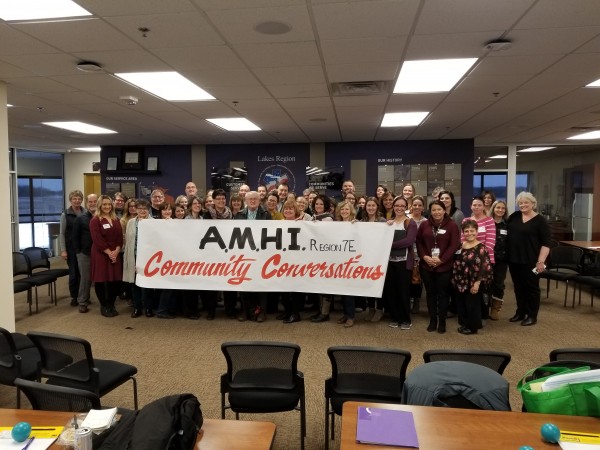
North Branch Conversation
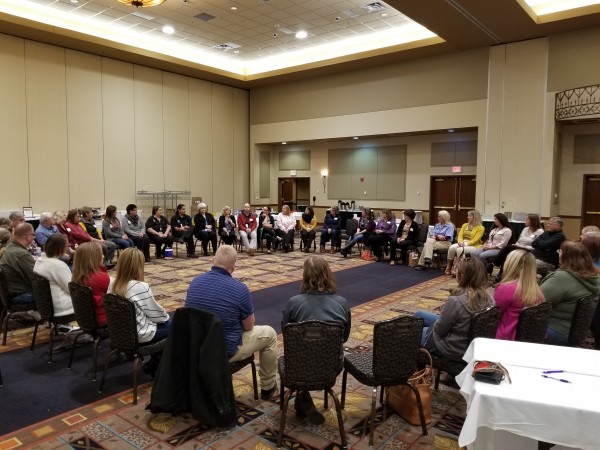
Grand Casino Hinkley/Mille Lacs Band of Ojibwe Conversation
Indigenizing Crisis Intervention Teams in Indian Country
With our Host Planning Teams in Pine Ridge, Rosebud, Rapid City and Minneapolis and with individuals in several other Indigenous communities around the country, the Barbara Schneider Foundation (BSF) is working to improve crisis response, prevent crisis, and to support recovery and wellness in Indigenous communities.
Nationally, BSF provides de-escalation training in the Crisis Intervention Team (CIT) model, which promotes partnerships among the three core elements of Public Safety, Mental Health, and Community Advocacy. The training focuses on assisting individuals with mental illness and improving the safety of patrol officers and other responders, consumers, family members, and community members.
The nexus where the three core elements or circles of partnership overlap provides the vital space in which BSF conducts its four-part Community Conversations series – respectively titled Discovery, Dream, Design, and Destiny. Incorporating methods of Appreciative Inquiry dialogue into our CIT work, BSF facilitates dialogue about what gives life to human systems when they function at their best. It is based on the assumption that questions and dialogue about strengths, successes, values, hopes, and dreams are transformational. It suggests that successful human organizing and change is a relational process of inquiry.
These are examples of the Community Innovation Teams that have emerged from this process:
Cross Cultural Communication – Working to increase cultural understanding and shared community experiences between Natives and non-Natives.
Healing & Transformation – Working to bring diversity of approach and increased compassion to community wellness efforts.
Mitakuye Oyasin – Working to spread the concept that we are all related, that all humans, animals, plants, earth, and sky share this universe.
Technology – Working to keep our Community Conversation participants, teams and leaders connected, informed and engaged through email and social media.
Wasuyapi – Working to support efforts to reduce incarceration for non-violent offenders and to provide assistance for the Native community involved with law enforcement.
Here are some media links that help tell the story:
Lakota Nation Invitational Conversation
Rapid City Community Conversations Website
jan.19 Invitation to Pine Ridge Community Conversation
INSATIABLE: A YOUNG MOTHER’S STRUGGLE WITH ANOREXIA
www.ericarivera.net/p/insatiable.html
 At twenty-four years old, Erica Rivera appeared to have it all: a B.A., two daughters, a successful husband, a house in the suburbs—and a great body. But under the surface, Erica was struggling with an addiction. What began with a diet to lose the baby weight after her second daughter’s birth spiraled into a self-destructive obsession with dieting, bingeing, purging, exercising, and, ultimately, anorexia.
At twenty-four years old, Erica Rivera appeared to have it all: a B.A., two daughters, a successful husband, a house in the suburbs—and a great body. But under the surface, Erica was struggling with an addiction. What began with a diet to lose the baby weight after her second daughter’s birth spiraled into a self-destructive obsession with dieting, bingeing, purging, exercising, and, ultimately, anorexia.
Although the addiction to her eating disorder, and the depression that stemmed from it, nearly cost Erica her life, it wasn’t until her very young daughters began to imitate her actions that she decided to get help. Tracing her disordered eating and body-image patterns across three generations of women in her family, Erica was able to get to the root of her own problems and show her daughters where happiness truly lies: in loving oneself.
BSF, CIT Int’l & National Institute of Corrections Online Training
Major Sam Cochran consults with CIT Trainer, Deputy Chris Douglas, and CIT Training Actor, Dominic Kanaventi, who are both active in BSF’s CIT work. They provided a mental health de-escalation scenario for the NIC national online training for corrections. Charles Jensen, a Trauma and Recovery Specialist with BSF, had a major part in the planning and content of the training. View the training by going to the link on our training page.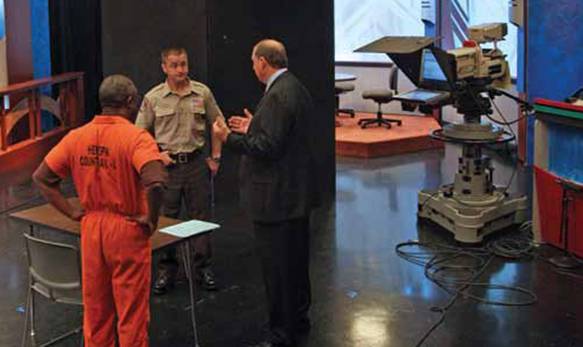
40 hour Memphis Model CIT Training
BSF Partners with the Hennepin County Sheriff’s Office to provide 40 hour Memphis model CIT training with a train the trainer model. Classes are open enrollment each year in April and November. See training page for details. This class is also available in your community.
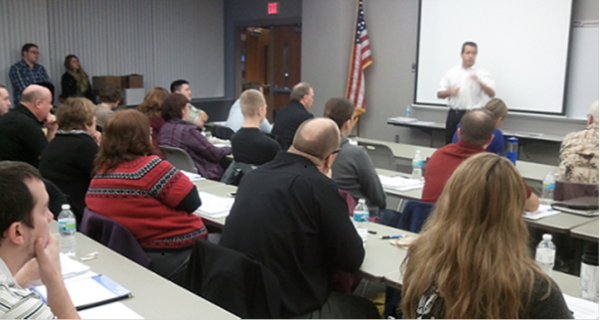
Online Mental Illness Training for Law Enforcement: Easy Access to a Difficult Topic
PRODUCED BY AND REPRINTED WITH THE PERMISSION OF THE MINNESOTA CHIEFS OF POLICE ASSOCIATION
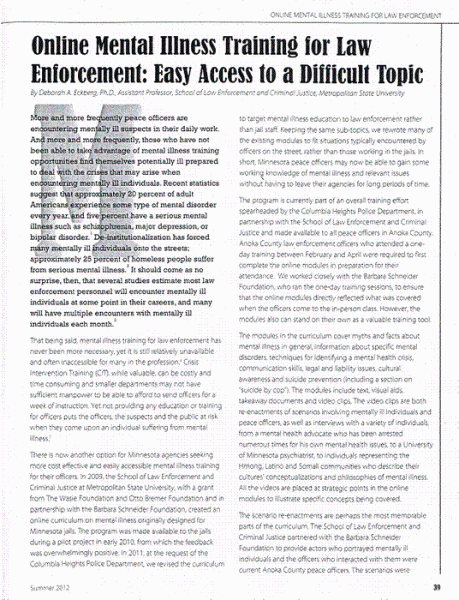
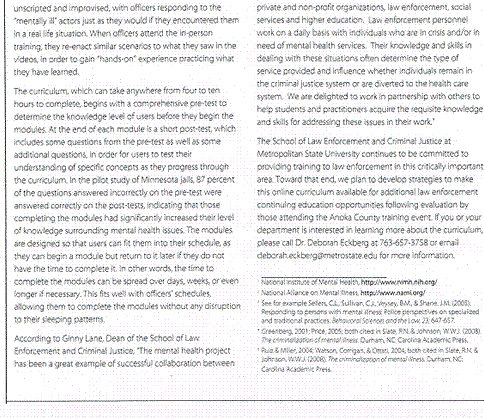
In Favor of a Collaborative Law Enforcement Approach to Assisting Those with Mental Illness
PRODUCED BY AND REPRINTED WITH THE PERMISSION OF THE MINNESOTA CHIEFS OF POLICE ASSOCIATION
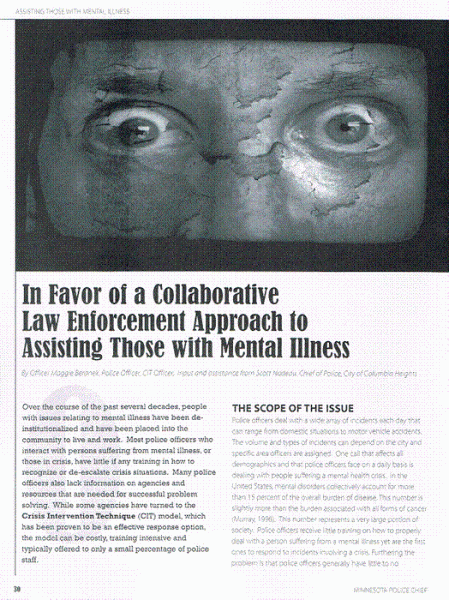
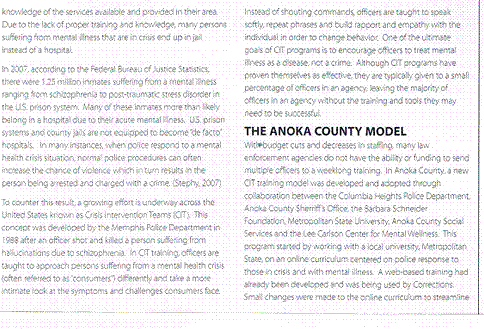
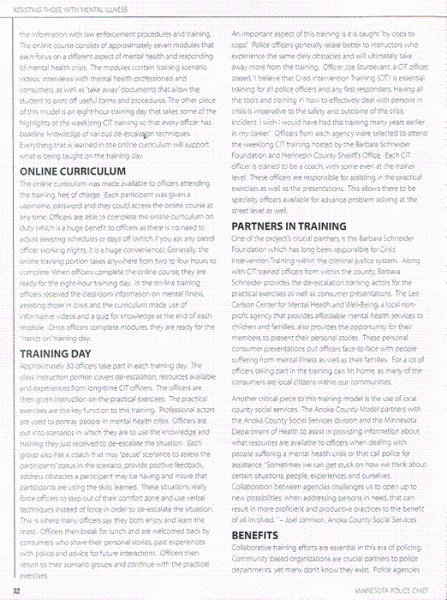
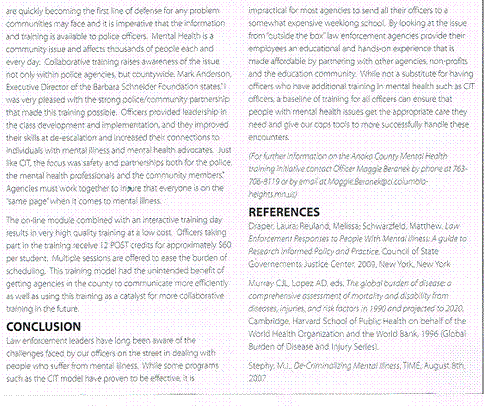
THE TEACHER’S GUIDE TO STUDENT MENTAL HEALTH
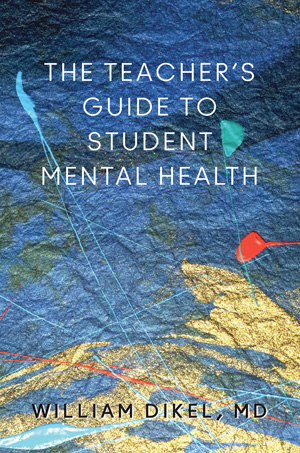 Order online at W.W. Norton Books
Order online at W.W. Norton Books
Teachers will learn the differences between normal child and adolescent behaviors and behaviors that reflect underlying mental health disorders, and will recognize where these behaviors fall on a spectrum, ranging from behavioral (planned, volitional acts that clearly have a function) to the clinical (where a mental health disorder is causing the behavior).
They will also learn how to communicate effectively with their school teams (and student families) to ensure that school mental health staff (psychologists, social workers, counselors, and nurses) will be able to provide appropriate interventions for students in need. Administrators will learn the importance of creating a district mental health plan that clearly defines the roles of teachers, mental health staff, principals, and others, with the goal of establishing a seamless system of coordinated professionals all working to meet the student’s needs.
Youth Trauma Linked to Later Ills
Article by: JEREMY OLSON , Star Tribune
Survey: Childhood stress can increase disease, anxiety and drinking in adulthood. Stress and trauma in childhood tend to lead to anxiety and poor health in adulthood, according to Minnesota’s first-ever survey of adults about “adverse experiences” in their youth.
More than half of the 13,520 Minnesotans reported at least one traumatic experience in their childhood, including physical abuse, parental divorce or the incarceration of a household member. Those who reported multiple events had higher rates of chronic diseases such as asthma and mental disorders such as depression.
“They’re at the heart of many of the leading causes of death and disability,” said Dr. David McCollum, who works in the injury prevention unit of the Minnesota Department of Health.
The department released the data Monday, making Minnesota the 18th state to survey adults about youth trauma. The survey builds on research by the U.S. Centers for Disease Control and Prevention showing that traumatic events in childhood can cause toxic levels of stress that actually alter children’s brain chemistry. Other research has correlated such childhood events with suicide, unintended pregnancies, illicit drug use and sexually transmitted diseases.
“Stress becomes hard-wired in the body, and that is expressed throughout life,” said Laura Porter, former director of the Washington State Family Policy Council. Her state was among the first to study the relationships.
Verbal abuse was the most common among the nine categories of childhood events in the survey, followed by living with someone who has a drinking problem. One in 10 respondents reported sexual abuse in childhood and one in seven reported physical abuse. McCollum said the type of events didn’t matter; the higher the number, the more likely they were to correlate with problems in adulthood.
One in four Minnesotans in the survey reported four or more adverse experiences. They were twice as likely to be chronic drinkers and at least five times as likely to suffer anxiety.
The research doesn’t prove that childhood traumas cause adulthood problems, only that there is a statistical relationship. These experiences also had a profound link to overall well-being, said the Health Department’s Pete Rode, and were associated with a higher likelihood of dropping out of high school, being unemployed or worrying about paying for rent and food.
Research on the impact of childhood experiences began in the 1990s with a California doctor who wondered why some adults were dropping out of his otherwise successful weight-loss program. A review of medical records showed strong correlation with problems in childhood.
Porter said the research in Washington gave parents a new appreciation of the power of childhood experiences. Some parents revamped the way they treated their children; neighbors often showed more compassion to people with traumatic upbringings.
One concrete change in Washington was alternative sentencing for mothers convicted of nonviolent crimes, so they could raise their children and prevent the severe stress of separation.
Minnesota’s report recommended no such specific changes. It urged a similar effort to raise public awareness, along with financial and other resources to deal with the lingering problems of childhood trauma.
McCollum said the findings do not mean that someone has an unchangeable “destiny” just because of problems in youth. It does mean the state needs to understand the risk factors and help children and adults cope, he said. People can’t just say, “Time will heal things. Just put it behind you. Pull yourselves up by your bootstraps,” he said. “It doesn’t work.”
Jeremy Olson • 612-673-7744
Share of Minnesotans who reported childhood exposure to:
- Household member – 7% incarcerated
- Sexual abuse – 10%
- Physical abuse – 16%
- Mental illness – 17%
- Problem drinking – 24%
Source: Minnesota Department of Health



